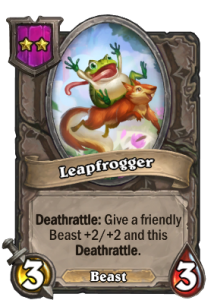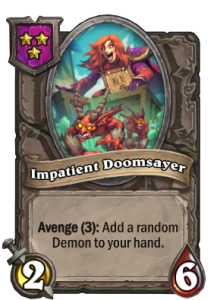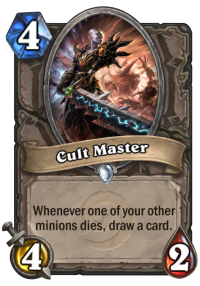Note: This article was written before yesterday’s patch, so some of the things discussed might have already changed (mostly for the better).
The massive Battlegrounds revamp brought along many new gameplay elements: multiple bugs just as massive as rework itself, but also various new heroes, many reimagined units and shifts to tribal identities made to ensure a better fit for the game mode. There’s also a new keyword, which has been a source of major consternation in the current metagame: Avenge, which may currently be a mere enabler of doom and buddies but could very well become much more than that further down the line, potentially even outside of Battlegrounds.
Battlegrounds 2.0: A (Buggy) New Dawn
 To start out, the reimagined Battlegrounds experience has been full of odd bugs and controversial design decisions. From the bugged C’Thun/Dragons interaction to the very existence of Whelp Smuggler, Impatient Doomsayer and Leapfrogger, there are many reasons to disagree with the notion that the game mode is finally ready to shed its beta tag.
To start out, the reimagined Battlegrounds experience has been full of odd bugs and controversial design decisions. From the bugged C’Thun/Dragons interaction to the very existence of Whelp Smuggler, Impatient Doomsayer and Leapfrogger, there are many reasons to disagree with the notion that the game mode is finally ready to shed its beta tag.
Dissecting the technical issues involved with the spaghetti code and the inner workings of Unity is beyond the grasp of a mere writer but the design decisions made are a different story. Each tribe now has a reliable way of scaling and has multiple archetype-defining cards made to tightly fit the game mode, but many of them are offered at such an aggressively low tier level that players can find and stick with what is basically an endgame composition as early as turn five, making the Battlegrounds experience akin to a game of musical chairs with everyone trying to find Impatient Doomsayer and Rat Pack as soon as possible before power-leveling as far as needed to secure a strong endgame.
Based on what we’ve seen so far when new content gets introduced to the game mode, there’s little to suggest that Team 5 has the expertise or interest to fine-tune cards to this level in Battlegrounds, and indeed it’s the very fact that low-tier units are composition-defining in the current meta that’s been such a source of frustration for many with the new-look 2.0 experience. In a way, all of the devastating endgame builds (Demons, Leapfrogger, and to a lesser extent, fully Poisonous Murlocs) are enabled by an Avenge card, which makes for an interesting reading of the early BGs 2.0 metagame.
It begs the question: just what makes it so quietly effective?
Avenging Angels: The New Keyword in Battlegrounds
Many of the new and reimagined cards in BGs aim to promote consistent scaling for early minions, sometimes even based on in-combat scenarios. Nowhere does this element become more apparent than in the case of Avenge, the new keyword which generates some sort of a resource for what is the simplest and most standard element of every (auto)battle. This, in principle, should let you stick with your existing composition for a little longer as you generate a bit of extra resources at what you would expect to be a bit of a stats-related sacrifice on the Avenge card itself.
 So far, this cost-benefit equation is brutally out of balance. To address the elephant in the room, Impatient Doomsayer is the make-or-break card of the first six turns in BGs as those fortunate enough to snatch it early on Tier 3 will then be locked into a very advantageous position and a clear archetypal path from that point onwards. The small and synergistic pool of Demons offered by the card means that you get much more than just the one gold for the minions you end up selling, be it regular triples, bonus money from Soul Devourer or an overly reliable way to find high-tier minions as you power-level your way to glory. Your sacrifice for all this? “Only” getting eight stats for the minion, at an advantageous distribution, too.
So far, this cost-benefit equation is brutally out of balance. To address the elephant in the room, Impatient Doomsayer is the make-or-break card of the first six turns in BGs as those fortunate enough to snatch it early on Tier 3 will then be locked into a very advantageous position and a clear archetypal path from that point onwards. The small and synergistic pool of Demons offered by the card means that you get much more than just the one gold for the minions you end up selling, be it regular triples, bonus money from Soul Devourer or an overly reliable way to find high-tier minions as you power-level your way to glory. Your sacrifice for all this? “Only” getting eight stats for the minion, at an advantageous distribution, too.
Similar issues emerge from the design of Bird Buddy: it adds up to enough extra stats in a nascent Beast comp that you can take an extra turn or two trying to brute force the Leapfrogger build (which doesn’t rely on high-tier minions anyway with the obvious exception of Baron Rivendare). SI:Sevfin serves as the sole enabler of late-game Murloc comps, and the fact that it takes time to build up all the Poisonous buffs doesn’t make up for the fact that it is nearly inevitable that you will do so (at a cost of only one card, unlike previous Toxfins you had to use before). Avenge’s triggers happen naturally during combat, often up to ten times in a fight, making the current rewards way too good for the health of the metagame.
The simple solution is to up by count by one on deaths required, but that would nuke some of those cards out of existence. The consistent impact of Avenge cards is fine, it’s a large part of what makes them interesting: it’s part of why Tony Two-Tusk might as well not exist. Smaller rewards, especially less permanent ones, would serve the gameplay experience well. Imagine a card like Bird Buddy giving +1 Health to everything with no Attack buff. An Impatient Doomsayer giving a Coin. Something like Avenge (2): Freeze a minion, meaning it would skip one attack in the fight. The possibilities are endless but they likely won’t be utilized, with nastier and more meta-defining payoffs offered instead.
Avenge in Constructed: A Pipe Dream or Something More?

In a way, Avenge (1) has been a part of the game since its earliest days: it’s basically “whenever (or after) minion dies” trigger – Flesheating Ghoul and Cult Master are just two examples. With Rush becoming a core part of the gameplay experience (and even if the current Questlines meta may suggest otherwise, minion combat is actually a key part of Hearthstone), offering small tangible payoffs off the back of back-and-forth trades could make for a really interesting feature, especially in modes with lower power levels like Arena.
Higher Avenge counts would be pretty difficult to introduce in Constructed, where attacks aren’t random and you can’t hope that an Avenge minion will survive until the end of combat. But something like Avenge (2) or maybe even Avenge (3) might be worth considering for some pretty good payoff.
Avenge has already proven to be an impactful keyword in Battlegrounds, and with some fine-tuning, it can be a truly great addition to the game. However, its resource-generating properties can easily get out of hand, and so far it seems like alternative uses and tempo-oriented reimaginings would remove a lot of the frustrations currently involved with the cards using it, as the amount of value available to those lucky enough to find a card like Impatient Doomsayer early on is simply way too high, leaving no room for those less fortunate to catch up – unless they find some other highly relevant Avenge card, that is. The design space available is massive across multiple game modes, but making use of it would require Team 5 to have more restraint and focus on smaller effects instead of grandiose, game-winning ones.

Avenge was refreshing. But yes they need to controle level power of some cards, and they did it with this nerfs. 🙂
In Constructed, maybe works on cards like Secrets. 😀 Maybe like a fair (and small rewarded) questline.
Leatherworking Kit functions like Avenge with the slight limitation of beasts.
Weapons are one way to work in the Avenge mechanic. Secrets are another since they sit over the top of the board like weapons and persist over multiple removals.
Honest question – which Avenge card was key to Leapfrogger strategies? I thought it was based on Macaw, Frog and Baron.
Regarding Constructed – I could very well see that keyword becoming Legacy (is that what it’s called? idk exactly).